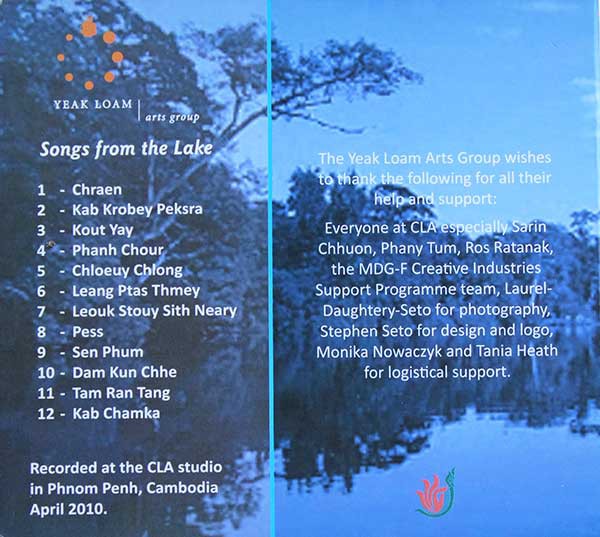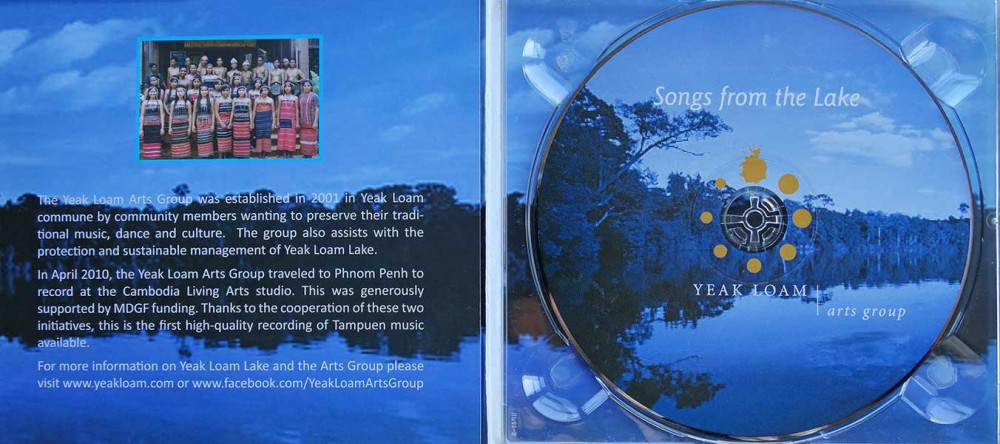





This is a unique studio recording of music that was until now only available in its traditional setting, so-called fieldrecordings. This is a UNESCO-sponsored album with traditional music of the animistic Tampuen people indigenous to Ratanakiri province in Northeast Cambodia.
Because the repertory was chosen by the tribe members themselves it is a coherent, but not complete, collection of music that alternates between instrumental gong pieces and pieces with singing and other instruments like bamboo flutes and string instruments. They are arrangements of pieces that, depending on the traditionally ritual occassion, are performed in differing lengths.
From the Phnom Penh Post:
The group is named after the Yeak Loam Lake in Rattanakiri province, where they reside. It is a place of eerie beauty: nestled in the circular crater of an extinct volcano, the water is crystal-clear and surrounded by lush, semi-deciduous forestland.
Around the lake are five villages – Lapoe, Lon, Sil, Chree and Phnom – that are home to the Tampuen, a minority group who hold animistic beliefs and who consider the lake and forests to be inhabited by powerful spirits.
The area’s beauty has proven to be a blessing as well as a curse. In 2007, members of the Tampuen community formed the Yeak Loam Arts Group with the aim of preserving the region’s traditional music, dance and culture in the face of encroachments on indigenous lifestyles from outsiders seeking to buy up and develop land around the lake.
Group spokesperson Van Cae explained that the survival of Tampuen culture was dependent on the health of the lake and the forests that surround it.
“The forest is very important to us. If there is no forest, life will be very difficult for the villagers,” he said. “If they take the land and the lake, it will mean the loss of our culture, the loss of everything. That’s why we want people to understand our culture.”
Meas Hurn, the group’s team leader, said he hoped that making a studio recording of their music and releasing it on CD would help teach people about Tampuen culture and raise awareness about the dangers posed by unscrupulous development.
The songs themselves serve as an introduction to the musicians’ culture. Traditional songs cover the gamut of Tampuen life, from infancy (“Pallam Kon Bom Pay”, or Lullaby Song), to work (“Paih Bok Srou”, or Pounding Rice), to making religious offerings (“Trom Koll Ka Pow”, or Placing the Buffalo Head on the Ling Cross), to death (“Bot Bun Sop”, or Funeral Songs).
The group also plays newer songs that will sound traditional to the untrained ear, some written during the Khmer Rouge era and others composed more recently by team leader Meas Hurn. A few of these deal with decidedly modern topics, including “Karob Chbab Carachor” (Respect Traffic Song) and “Bongkan Preteat Ka Pear Pak Retan” (Protected Area Song).
The recording sessions took place at the Cambodian Living Arts (CLA) Studio on March 31 and April 1. Phany Tum, the country manager of CLA, said the recordings were part of the organisation’s main work, which is supporting “the revival of traditional performing arts as well as supporting the creation of new works of art”.